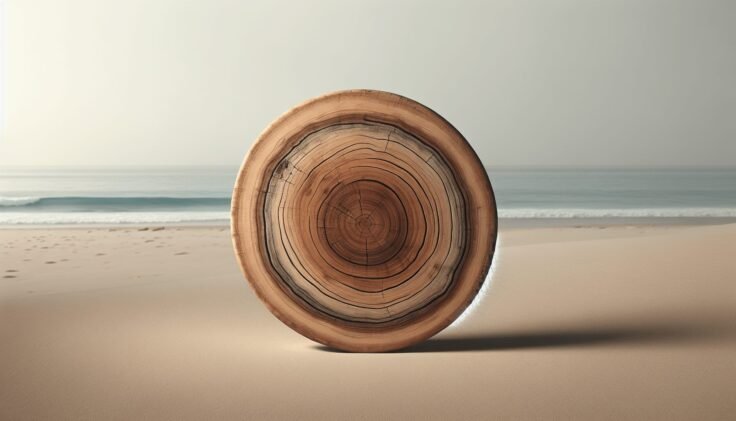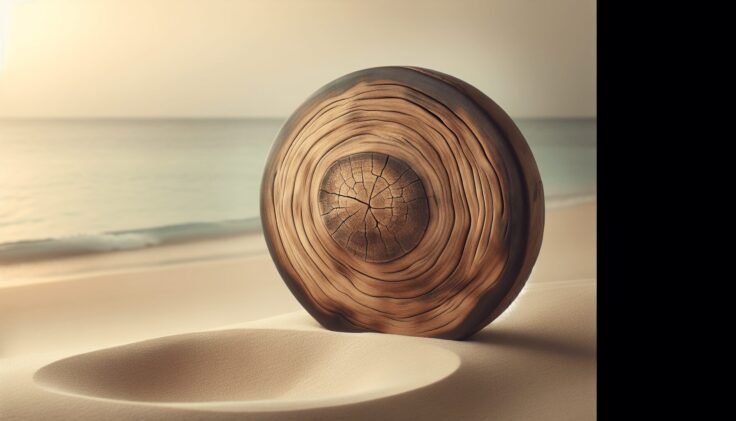Have you ever stumbled upon a piece of driftwood during a walk along the beach and wondered about its story? Driftwood, often shaped and polished by the sea and elements, carries with it tales of its journey from tree to water and finally to shore. One of the most intriguing formations of driftwood is when it takes on a circular shape. This natural phenomenon is not only captivating but also full of interesting insights into the forces of nature at play.

Understanding Circular Driftwood
Circular driftwood is a unique form of driftwood that has gained popularity among artists, interior designers, and nature enthusiasts. Its shape is often attributed to the natural forces that mold it, like water currents and sand friction, leading to perfectly rounded or hoop-like structures. Let’s explore what makes circular driftwood such a fascinating subject.
What is Driftwood?
Driftwood refers to wood that has been washed onto a shore or beach by rivers, lakes, or the sea, primarily due to weathering. It can originate from any type of tree, and the time it spends in the water before arriving on the shore can vary greatly. This prolonged exposure to water and environmental elements causes driftwood to take on unique textures and forms.
Formation of Circular Driftwood
The circular form of driftwood occurs under specific conditions where the water, wind, and wave action shape the wood continuously over time. Circular driftwood pieces can be quite rare, as they require consistent forces to achieve their symmetrical, round shape. These pieces often originate from branches or small trunks that naturally lend themselves to forming loops or hoops under the right conditions.
Natural Forces Behind Circular Driftwood
One of the main forces responsible for the formation of circular driftwood is the continuous motion of the water. As the piece of wood is forced to roll and tumble over time, the edges are smoothed out, eventually leading to a round shape. Additionally, the friction of sand and gravel in the water acts as a polishing agent, ensuring the wood remains smooth and uniform.
Uses and Appeal of Circular Driftwood
Circular driftwood’s unique aesthetic has captured the imagination of many. Its versatility and natural beauty make it a desirable material for various artistic and practical applications.
Art and Home Décor
Circular driftwood can serve as a striking focal point in art installations. Artists use its natural forms to create sculptures that reflect the interplay between nature’s chaos and symmetry. In home décor, circular driftwood is often repurposed as wall art, ceiling hangings, or even furniture elements like table bases and frames, adding a rustic yet elegant touch to interiors.
Garden and Outdoor Spaces
Circular driftwood also enhances outdoor environments. Whether used as garden art, integrated into landscaping designs, or as standalone pieces, it brings a naturally sophisticated ambiance to gardens and patios.
Symbolic and Cultural Significance
The circular shape in many cultures symbolizes unity, wholeness, and eternity. Circular driftwood can, therefore, carry metaphorical significance, potentially making it an ideal gift or memorial piece.
Circular Driftwood: Collection and Conservation
While circular driftwood is beautiful and intriguing, it’s important to consider environmental and legal aspects when collecting it.
Finding Circular Driftwood
Beaches, riverbanks, and lakesides are ideal places to search for circular driftwood. However, finding a perfect piece may take time due to its rarity. Respect the environment and ensure that collecting driftwood is allowed, as some areas have regulations to protect local ecosystems.
Responsible Collection Practices
When collecting circular driftwood, it is vital to only take pieces that have naturally detached and washed ashore. Avoid disrupting habitats or removing large quantities, as driftwood plays an essential role in providing food and housing for wildlife.
Conservation Considerations
Conserving and using driftwood responsibly helps preserve natural resources and maintain ecological balance. Always consider supporting or participating in local conservation projects that aim to protect coastal and river habitats.
Circular Driftwood in Craft and DIY Projects
Circular driftwood can be a fantastic material for your next craft project. Its natural beauty makes it an excellent choice for DIY enthusiasts looking to create something unique.
Craft Ideas Using Circular Driftwood
Creative possibilities with circular driftwood are nearly endless. Here are several inspiring ways you can transform this natural treasure into captivating crafts:
- Wreaths: Use pieces of circular driftwood to create rustic wreaths perfect for any season.
- Mobiles: Hang circular driftwood pieces alongside other natural materials to create mobiles that sway gently with the breeze.
- Mirror Frames: Encircle a mirror with pieces of circular driftwood to add an earthy touch to your home.
Tools and Techniques for Working with Driftwood
Crafting with circular driftwood requires a few essential tools and techniques to ensure a smooth process:
- Sandpaper: Use various grits to smooth any rough patches on your driftwood piece.
- Wire and Hooks: Secure pieces together or attach hanging hardware for wall art and mobiles.
- Sealants: Apply a wood sealant for protection and to enhance the driftwood’s natural look.

Circular Driftwood: Environmental and Ecological Impact
Understanding the ecological role of driftwood and its impact on the environment enhances appreciation for this natural wonder.
Environmental Role of Driftwood
Driftwood serves several ecological functions:
- Habitat: Provides shelter for small creatures and organisms.
- Nutrient Source: Gradual decay enriches surrounding soil and water with vital nutrients.
- Ecosystem Stability: Helps prevent erosion by breaking up wave energy along coastlines.
Balancing Human Interest and Environmental Needs
While it’s tempting to collect unique driftwood pieces, it’s crucial to strike a balance between human interests and environmental preservation. Consider enjoying circular driftwood as part of its natural setting, capturing its beauty through photographs instead of removing it.
Conclusion
Circular driftwood is more than just an exquisite piece of wood—it’s a testament to the beauty and complexity of nature’s craftsmanship. As you encounter these natural wonders during your seaside adventures, take a moment to appreciate their journey and the stories they tell. Whether you decide to collect, craft, or simply enjoy them in their natural environment, remember the importance of respect and conservation in preserving these defining features of our coastal and aquatic landscapes.